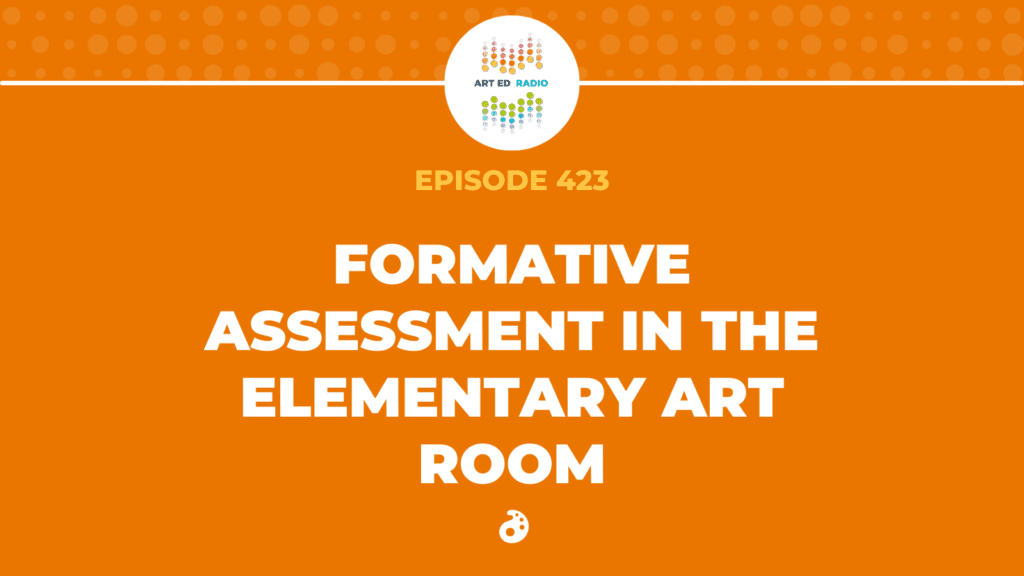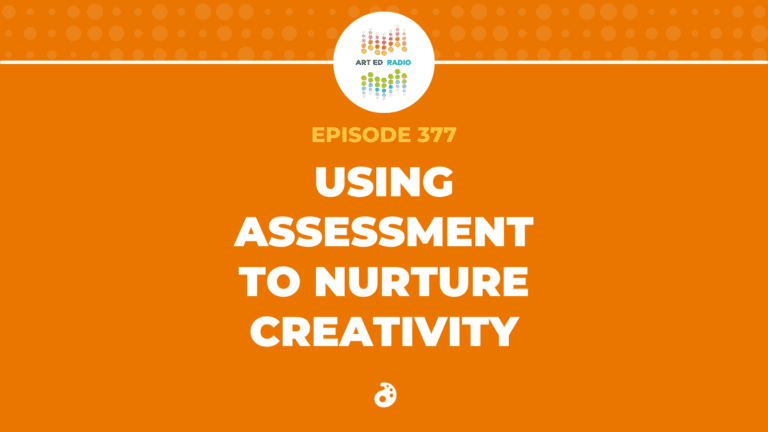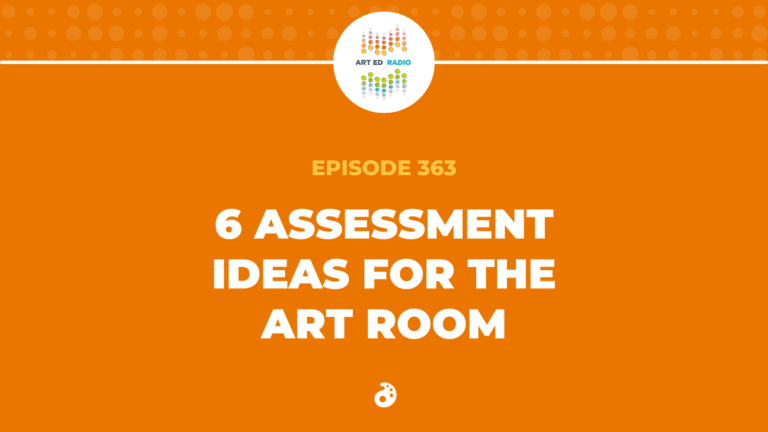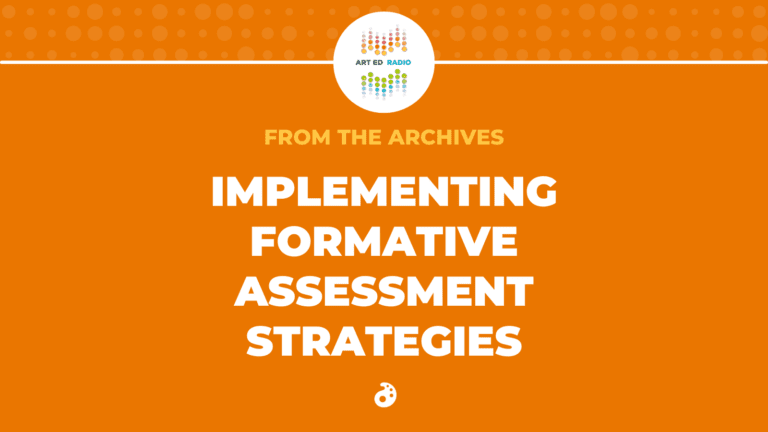In today’s episode, AOEU enrollment specialist Betsy Komarchuk joins Tim to discuss some of the most important things art teachers should know about formative assessment. Whether using assessment to check for learning, to guide instruction, or facilitate peer and self evaluations, Betsy has a plethora of ideas for utilizing formative assessment strategies in the art room. Full episode transcript below.
Resources and Links
- Strategies to Use Formative Assessment
- 6 Ideas for Formative Self-Assessment
- Ways to Gather Formative Assessment Data
- 6 Strategies for Fast Formative Assessments
- Find all the information you need for the NOW Conference

Transcript
Tim:
Welcome to Art Ed Radio, the podcast for art teachers. This show is produced by the Art of Education University, and I’m your host, Tim Bogatz.
In April, I went to the NAEA Convention in Minneapolis–always a wonderful experience, a wonderful event, we get to connect with so many art teachers, and learn so much.
On Friday morning of that convention, I got up REALLY early to go see Betsy Komarchuk talk about formative assessment–and let me tell you, nothing is quite as exciting as formative assessment at 7:30 in the morning–but she did an amazing job, and as I was in the presentation, I thought some of her ideas would make for an excellent podcast. Betsy works for AOEU as an enrollment specialist and student coach, and she actually worked with me when I was taking AOEU graduate courses in the fall. So shout out to her for everything that she does, and I’m excited to have her on today. We’re going to talk about some basic strategies, some more advanced ideas, and some ways to use formative assessment that you may not have thought about. We will also link a few good resources in the show notes so you can explore things a little bit more. But for now, let me bring on Betsy!
Betsy Komarchuk has joined me now. Betsy, how are you?
Betsy:
Great! How are you, Tim?
Tim:
I am also great, thrilled to talk about formative assessment as people usually are. and No, I think it’s a good conversation that we already have.
I think we need to talk about it more as teachers. So um I guess to to get started, to kind of set the stage for everybody, when you and I were at the NAEA conference, along with a bunch of the AOEU team in April. I came to see your presentation on formative assessment and its benefits, which I loved. I thought to make a great podcast topic, so here we are. Thank you for for coming on. ah But can you talk really quickly about why you were interested in formative assessment or why you think it’s important?
Betsy:
Yeah, absolutely. So, you know, formative assessment, I think, as you put it, is not typically an art teacher fave.
This can often be associated with, you know, tests or extra papers or records, which is something that art teachers don’t really have the time or capacity for, understandably so.
Tim:
Yeah.
Betsy:
But it turns out that there are quite a few strategies that are easy for art teachers to implement and will actually make their lives easier when it comes to lesson planning, engagement, and student success.
Tim:
Yeah, well said. Okay. And I want to talk about all of those things, actually. But before we get into specifics, I would love for you, if you can, to just talk about the benefits of of formative assessment, maybe a a few more specifics of how it can help teachers and and how does it help students.
Betsy:
Yeah, absolutely. So formative assessment monitors student learning before and throughout the lesson. This is actually backed up by research. So an educational researcher named John Hattie has shown that students have been positively impacted by quality teacher assessment. So here’s a couple of those benefits that we found. So, I help identify learning gaps or prior knowledge that students may have. And this is a great way to help inform your instruction. So you know students can have varying levels of knowledge when they come into an art room.
Some students might go to a summer camp and pick up a few skills that their peers may not know yet. Or you might have new students that come into the district and their previous district didn’t have art. So they’re lacking a few of their other skills that they should have by now.
Tim:
Yeah.
Betsy:
So, you never know where your kids are at when it comes to the arts. So this is a great way to kind of help assess that and figure out If anything needs to be revisited before you dive into a unit, um do accommodations need to be made? Do you some students need to have um extra support or challenges?
Because maybe they just are a little bit more gifted than their peers. um And you know you can also avoid preparing a lesson that you have spent all this time um preparing and thinking that it’s amazing and your students are absolutely going to love it. only to find out that they did it last year.
Tim:
Oh my God, that has happened to me. ah Like when I was what second-year teacher, I think ah at the high school, I had this huge like dream house drawing that I love, thought was super original, thought was super cool, later came to know everybody does that.
But I went into it and like half of my students had done it in middle school the previous year and Had I just known, had I done a little bit of checking beforehand, it would have been so much better for for all of us. But anyway, sorry to interrupt with that.
Betsy:
Oh, no, please do. Yeah, I mean, it’s definitely happened to me as well. When I was a teacher at my last school, and I just moved into that district, um, I started a beautiful second-grade lesson.
It was one of those that, you know, you’ve seen on Instagram and I was just and was doing it for the first time, I was excited about it.
Tim:
Right.
Betsy:
And my students were all told me that they they did it last year. It’s like, okay, let me start. It’s okay. But yeah, so forward assessment can help avoid situations like that, which is great.
You can also avoid starting a lesson only to find that, you know, your students have significant learning gaps and they cannot move forward in the lesson until you address those.
Another benefit for formative assessment is that students feel seen and heard when their teacher focuses on their needs. you know Students will respond really well to that. They want to feel like their teacher is teaching them something that they specifically should be able to do, which is great.
Everybody wants to feel seen and heard. right Another benefit is that students can put more of an emphasis on the process rather than the product. And I think a lot of our teachers are always striving for this and it’s really easy for students and teachers to get caught up in the final product.
Tim:
Yeah. For sure.
Betsy:
You know, you see that beautiful project either on Instagram or just that example in your classroom and um you kind of forget that a lot of that learning is actually happening within the process and it’s not just about that final product. So formative assessment can also help with that as well. um And then finally, you can improve your overall quality of art making. So by identifying what students need, you can better accommodate them from the start of the unit and better prepare them as they work.
Tim:
Oh, that’s a lot of great answers. So thank you. No, I think a lot of important points there, especially about just the the idea that so much of the learning comes through the process. But then when you focus on that, like your end result does become better.
Betsy:
Okay.
Tim:
Like as kids are learning more, the the quality of their work does go up.
Betsy:
Exactly.
Tim:
And so I think that’s an important point to remember as we’re and we’re kind of moving through this. so I would love to also talk about just some basic assessment strategies. If you don’t mind, you mentioned that in your your first answer. But what are some things that that maybe teachers are doing every day, but they don’t necessarily think of them as assessment strategies?
Betsy:
Yeah, I love that you asked it that way because chances are you’re already doing some of these things without even realizing it. So we can identify what you’re doing and then be a little bit more strategic about it, which is great.
So for example, checking for understanding is something that our teachers are innately doing anyway.
Tim:
Yeah.
Betsy:
It could be as simple as your class discussions or observations so you finish up instructions on your project for the morning and say okay after you grab your paper the first thing you’re going to do is students fill in the blank that’s a great way to just very basic check for understanding make sure your students are getting it and they know what to do
Tim:
Yeah.
Betsy:
You can also use your sketchbooks, signing prompts or sketch notes or thumbnail sketches, diagrams or concept maps, just anything that will help students map out what they’re doing for their project and just kind of checking for understanding, make sure they got it along the way. You can use kinesthetic signals, which I absolutely loved at the elementary age.
Tim:
Oh, I’m a huge fan. Huge fan. Oh, I, I even do it in high school because high schoolers don’t want to talk to you, you know?
Betsy:
Yes.
Tim:
And so if they can just like give you a thumbs up or, you know, shake their head at you, that that’s usually a little more.
Betsy:
Right.
Betsy:
Any sign of life, yes, exactly.
Tim:
Yes.
Betsy:
So yeah, a couple of those things, like you mentioned, a thumb up, very, very simple. I always like to end my um class discussions or instruction with my elementary students with just, hey, give me a thumb up if you know what to do, give me a thumb down if you don’t. If I see a lot of thumb downs, I know I need to readdress something and that’s okay.
Tim:
Right?
Betsy:
Red, yellow and green cups. So if you have um those red, yellow and green cups just kind of stacked in front of students at their desks and they always have it on green. um but they can change it to yellow if they feel like you know they need you to stop by and check in on them.
Tim:
Mm-hmm.
Betsy:
Maybe they have a question or two. It’s not a big emergency, but just come and stop by when you have a second.
Tim:
Yep.
Betsy:
Or they put it on red when they really need you to stop by right now and check in on them. They are lost.
So that’s a great way to self-identify as well. um And then you can also do the four corners. So you can say something like, go to corner one if you feel like you got it. Go to corner two if you feel like you can teach it to someone else. Go to corner three if you have some questions, or go to corner four if you feel lost. And this is not something I would do with every class.
Tim:
Yeah. Yeah.
Betsy:
Some students aren’t comfortable self-identifying that way.
Tim:
Right, right.
Betsy:
Understandably so. There’s some classes I would absolutely do this every day with. And then there’s some classes I would never do this with. you just You know your students best. You know what they like to do. So implement it as you see fit. um And then you can do some formal strategies. So entry and exit slips are great, quizzes, polls, surveys, one-on-one conferences, um any formalized strategies like that.
Tim:
Yeah, and those are great. I actually love all of those ideas. I think all all of those formal strategies can be really effective as long as you and don’t you know overuse them. But I think that’s all good.
Now, you just said something about being more intentional ah with how we use our formative assessment. So I’d love to to dive into that thought if we can. If we’re thinking a step behind beyond just what we can use. Let’s talk about how teachers can use formative assessment to kind of guide instruction or guide their teaching. Can you get into a few more details on that?
Betsy:
Yeah, absolutely. So like you said, formative assessment, we can use it to inform instruction, but like how do we go about doing that? So this can feel really intimidating with the amount of students that we teach, especially if you teach elementary and you teach hundreds of kids.
Tim:
Yes.
Betsy:
I do need a lot to keep up with. Yeah, but there’s ways that this can be done efficiently and effectively. So this could look like a survey or a questionnaire and you can do with paper, but my favorite is to do it digitally. So it keeps all the papers away and it actually organizes all of your data really easily.
Tim:
yeah
Betsy:
And then you can use their responses to gather information on their prior knowledge, their interests, and then you can kind of plan your instruction around all those things.
Tim:
Yep.
Betsy:
So you make sure that you’re you’re planning engaging lessons that you know that they’re interested in and that you know that they can handle based off of their prior knowledge.
Tim:
Yeah, for sure.
Betsy:
You can adapt instruction to meet student needs, so you can offer scaffolding if your students need it, um provide additional challenges. Like we mentioned earlier, if you have the student that went to summer camp and they just they know everything with art, we all have one of those students that just, they’re a go-getter and they they know a little bit more than their peers, which we absolutely love and adore.
Tim:
yeah
Betsy:
So you want to provide additional challenges for them just to make sure that they feel like they’re being included as well because um they’re going to get bored and tune out if they feel like they know it, they’ve done it, they’re past it.
Tim:
Yeah.
Betsy:
You can shorten projects if they become a little too much. I know I have done this a few times. I just kind of realized, you know, this is week four and I only see you once a week. We got to move on.
Tim:
Yeah. Yeah.
Betsy:
That’s okay too. Or you can extend your deadlines as needed, which, for me in high school, I found to be really critical because my students were really engaged in what they were doing. They’re doing a great job, but they just need more time. And I don’t want them to feel rushed.
Tim:
Yeah,
Betsy:
I don’t want them to feel pressured. So yes, let’s give you a few extra days to get this done and do it well.
Tim:
yeah I think the key is just to be flexible there, but that is that is some great advice, so I love that. I also wanted to ask you, part of the presentation that that I saw from you that I was really intrigued by was the peer evaluation strategies. I think you have a lot of those that can be effective. ah Can you maybe share just a few of those peer evaluation strategies that that you think work well for for students?
Betsy:
Yeah, for sure. So peer feedback can directly affect a student’s direction in their project. You know, oftentimes they listen to their peers more than adults.
Tim:
Very true, very true.
Betsy:
I mean, no one’s shocked by that, right? Yeah, so I mean, they’ll appreciate teacher feedback, but they really trust their peers because their peers are living the same experience as them and they can relate better than adults can. So Students also enjoy that social learning component um that peer evaluation provides.
Tim:
Yeah.
Betsy:
And then above all else, they’re going to understand pop culture references that are just going to go over our heads for the most part.
Tim:
Yeah.
Betsy:
So it’s great for students to to see that and to have that peer evaluation. and They just get it. um So here are some things that you can do for peer evaluation for formative assessment. So one of these ideas is guess the message. So students will trade sketches for an assignment and guess what the other person is trying to communicate.
Tim:
Mm.
Betsy:
And this helps students understand how a viewer might interpret their imagery, which is a great lesson for students to learn. um Give one, get one. So students will circulate around the room with sticky notes. And they’ll give one compliment and one suggestion to a peer’s artwork. And then when they go back to their table and see their artwork, they’re going to have a lot of feedback in return. So that’s a great kind of low pressure way to get some feedback anonymously from your peers.
You can do a class swap. So if you have more than one class doing the same project, which you probably do, um you can trade those artworks and just kind of distribute. Then, students can write a letter to their assignment partner from the other class and just kind of say what they love about their artwork, what’s working, and maybe one suggestion that they would change. um but kind of just like a little, you know, nice little love letter, which also is a great way to um include ah writing and ah reading into your curriculum as well.
Tim:
Oh, yeah, yeah, that’s when that’s good.
Betsy:
Yeah.
Tim:
Anything else?
Betsy:
Yeah, so you can do what’s working, um which is when you ask pairs of students to um look at each other’s artwork and identify a single aspect that’s working well. So it’s great to hear all these suggestions all the time, but sometimes you want to just focus on what’s actually working and have students kind of focus on that positive aspect of it.
This is a great strategy to use for that. And then lastly, you can do two stars and a wish. So this is kind of like a um ah critique that you can do. So it’s when you pair students and have them review each other’s artworks and then ask them to identify um two things that they like about their piece so far and then maybe one wish for the next step. um So these are all great strategies.
Tim:
Yeah.
Betsy:
Before you implement anything, you might want to just have a couple of guidelines with your students that you go over before before implementing any of these strategies because it can be a little bit personal for them.
Tim:
For sure. for sure
Betsy:
So one strategy that I like to kind of go by is that students can take or leave the advice. So I mean, even just as a life skill, this is great to learn because just because one person tells you you should do something doesn’t mean you have to do it.
Tim:
Yeah.
Betsy:
Now, if you hear a couple people tell you that you should do it, then OK, take that into consideration. but um But yeah, students can take or leave the advice. It’s just a suggestion. It’s not set in stone. They don’t have to do it.
Tim:
Yeah.
Betsy:
um Then it’s also best to do this at the ideation stage so um students can get very attached to their projects, especially you know if they spent a couple days on it and there’s no going back after that.
Tim:
Right.
Betsy:
So you probably want to implement some of these strategies more at those initial stages before they get too attached. Then they’re much more inclined to revise them as they need.
Tim:
Yeah. Mhm.
Betsy:
And then lastly, you want to model and demonstrate how this should look. So a great way to go about this is if you take, you know, an old artwork or even if you have a picture of it from students way back, it’s completely removed from ah the students that you have now. So, you know, attached to it, students aren’t attached to it. And then just kind of demo what some of these strategies look like. So your students have an example to go off of.
Tim:
Oh, that’s all really good advice. And I think that the idea of having those guidelines for the peer evaluations, kind of sharing those before you do that, is something that’s important because a lot of teachers just assume that, you know, hey, let’s do these peer evaluations, ready go, and kids are are not ready for that.
Again, this is a spot where we maybe want to check for for prior knowledge and see where they are and just kind of
Betsy:
Yep.
Tim:
Like you said, pre-teach them what this is going to look like and demonstrate how we can do this and what it should look like. I think that’s something important to to keep in mind when You’re trying to get these peer evaluations up off the ground for for everybody. um One other thing I wanted to ask you about, ah you also have some really good strategies for self-evaluation and self-assessment that students can use.
Betsy:
Absolutely.
Tim:
I would love for you to to talk about those just a little bit, maybe chat about what formative assessments.
Maybe talk about what formative self-assessment can look like and how those types of assessments can help students.
Betsy:
Yeah, absolutely. So this can be ah challenging for students to understand because it’s a really personal experience for them. um And it requires critical self-analysis, which can take time for students to learn. I mean, adults are still learning this. So you definitely want to start it young if you can. So some strategies um that you can use to get started with a self-assessment is you know using those red, yellow, and green cards or cups. on Again, students just hold up the color that kind of self-identifies their readiness to proceed in a project or a concept. um You can use a self-assessment checklist. So students can utilize a teacher-created checklist of steps or criteria as part of their self-assessment.
Metacognitive about mastery so students can self identify whether they are confused and need help, um getting the hang of it or help others. um You know, when we talked about the thumb up, thumb down, I always like to say, okay, if you’re a thumb up, go find a thumb down and help them. And students absolutely loved it.
Tim:
Mm hmm.
Betsy:
And I love taking all the pressure off me to help all of these students.
Tim:
Yes, for sure.
Betsy:
That was great. And then you can use personal goal setting so students can actually set their own personal goals um for their project and include action steps to review their progress towards their goal throughout the project.
And then a midpoint rubric review, so students will use that final rubric as a formative assessment tool and check their progress towards their learning objectives.
Tim:
Yeah, and that’s all wonderful stuff. I really like that. I think that is kind of missing. I think for a long time, I didn’t do things like this with my students, you know, but I love the idea of the kind of empowering them, for lack of a better word, to just kind of self-assess, figure out where they are, what their learning needs are.
We’re going to end it right there, with a little bit of the conversation left. And if you’re interested in hearing the rest, you can come join us at the NOW Conference at the end of July! We will have a video presentation with this conversation in its entirety available in the after pass starting on August 2nd.
The full NOW Conference is happening July 31st, August 1st, and August 2nd. Day 1 is our kickoff event with games, and a ton of giveaways and prizes, and a couple of artmaking sessions. Day 2 is the main event with more artmaking, a plethora of presentations on all different topics for art teachers, and Day 3 you can revisit all of it, find some new presentations–like the video version of today’s podcast, and keep coming back with the after pass for an entire year after the fact.
All 3 days of the NOW Conference will be spectacular, I hope you can join us. And if you’re not registered yet, you can find all the information you need on the AOEU website.
I hope you enjoyed the conversation with Betsy, and I hope there were some good takeaways from it for you. Whether you’re using these assessment ideas for evaluation, or instruction, or peer conversations, or anything else, I hope you can find something that works for you and your students.
Art Ed Radio is produced by the Art of Education University with Audio Engineering from Michael Crocker. Thank you, as always for listening, and we will be back with you next week.
Magazine articles and podcasts are opinions of professional education contributors and do not necessarily represent the position of the Art of Education University (AOEU) or its academic offerings. Contributors use terms in the way they are most often talked about in the scope of their educational experiences.



